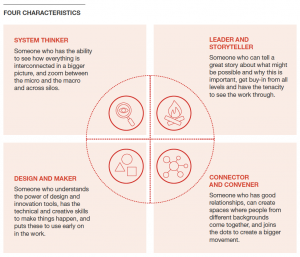
GUEST POST from Arlen Meyers, M.D.
In thinking about how these skills work together, they found it useful to apply the metaphor of DNA. Associating is like the backbone structure of DNA’s double helix; four patterns of action (questioning, observing, experimenting, and networking) wind around this backbone, helping to cultivate new insights. And just as each person’s physical DNA is unique, each individual we studied had a unique innovator’s DNA for generating breakthrough business ideas.
Associating is about pattern recognition, connecting dots and seeing what others don’t see.
These business school professors describe the creative mindset that they believe executives must embrace.
So, A stands for Attention, which is about noticing problems or opportunities that you and others previously missed by changing where and how you look.
L is for Levitation, which means stepping back to gain perspective and make sense of what you’ve seen to reflect on what you need to do differently.
I stands for Imagination, which involves connecting the dots in new and interesting ways to create original and useful ideas. Learn something new every day.
E is about Experimentation, which is about testing your promising idea and turning it into a workable solution that addresses a real need. Here is the value to experimentation in innovation.
Finally, N stands for Navigation, which is about finding ways to get your solution accepted without getting shot down in the process.
Here is another take on the theme

Innovation starts with mindset. Most scientists, engineers and health professionals don’t have it. However, there are ways to develop and change the gene expression by practicing epigenetic exercises. In case you missed that biology class, epigenetics literally means “above” or “on top of” genetics. It refers to external modifications to DNA that turn genes “on” or “off.” These modifications do not change the DNA sequence, but instead, they affect how cells “read” genes.
So, if you want to unlock your innerpreneurial genes, try :
- Associating, by realizing that sickcare USA cannot be fixed from inside.
- Associating by practicing open innovation
- Associating by thinking twice about thinking out of the box
- Questioning by being a problem seeker, not a problem solver
- Questioning why not instead of why and getting to why
- Observing by learning to see around corners. Avoid having to say “I didn’t see it coming” :
Look ahead of the curve – Track the trends and pay greater attention to the external environment. Beef up your information diet and endeavor to “get informed” rather than passively “be informed.”
Think ahead of the curve – Take the time to connect the dots, look for patterns of change, and emerging opportunities. Ask: where will this trend, technology or Driving Force of Change be in 10 years and what might I need to do in response?
Act ahead of the curve – Don’t wait for a trend to overwhelm you, take responsive action today. Disrupt yourself. “We must be willing to learn, unlearn and relearn to get ahead in this fast-paced digital world,” notes Jeff Thomson, president and CEO of the Institute of Management Accountants.
Here are 10 strategic trends that will drive data management. Did you see them coming?
- Observing by looking for the clues, not the roadmap
- Experimenting by using the business model canvas instead of writing a business plan
- Experimenting by applying your clinical or scientific mindset
- Networking by building robust internal and external networks
- Networking the right way when coldLinking
- Networking by learning how to meet up at a Meetup
- Networking by growing and engaging your alumni network
David Epstein explains in his book. Range, that specializing and practicing repeatedly works in environments that are “kind”. Tiger Woods excelled because he started young and engaged in a task and tried to do better. There were clearly defined rules and immediate outcomes that provided feedback. Doctors are also in this category and the educational establishment picks medical students who demonstrate narrow and deep thinking.
On the other hand, in “wicked” learning environments and domains, like entrepreneurship, the rules of the game are often unclear and incomplete, i.e. there are VUCA (volatile, uncertain, complex and ambiguous) conditions, there may or may not be repetitive patterns and they may not be obvious, and feedback i often delayed, inaccurate or both. Sometimes, you have to make up the rules as you go along and they are not necessarily transferable from one industry to the next because of the differences in industry ecosystems and cultures, like sickcare. That’s another reason why the clinical mindset is different than the entrepreneurial mindset and why it is so hard to find doctors with both.
Here are some more ways to sharpen your entrepreneurial skills.
Doctors have the potential to make great entrepreneurs because they have the DNA. No, they are not lousy business people. Downstream gene expression, though, is often a problem.
Image Credits: Pixabay, Design Council
![]() Sign up here to get Human-Centered Change & Innovation Weekly delivered to your inbox every week.
Sign up here to get Human-Centered Change & Innovation Weekly delivered to your inbox every week.
As most of you know, I believe the Innovators’ DNA is a toxic idea.
It’s not whether an individual is innovative or not, but instead, everyone is innovative in their own way.
Everyone has a role to play in innovation, and so I created the Nine Innovation Roles many years ago for my first book ‘Stoking Your Innovation Bonfire’.
People have translated them into multiple languages, and I have also created and made available for free download the card design for tarot sized cards to use in workshops.
Learn more at http://9roles.com